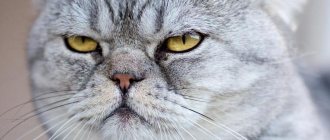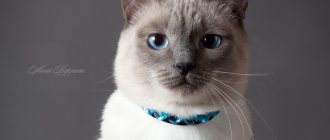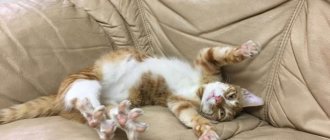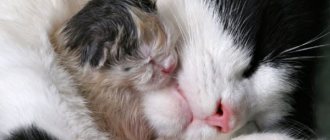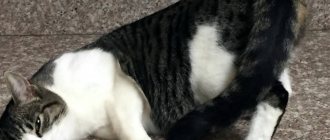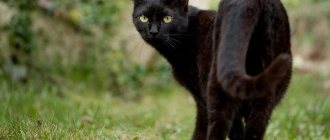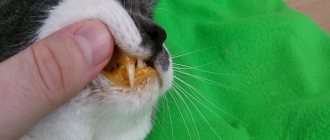A must read for all cat owners!
If you ask any veterinarian to name the weakest point in cats, the answer will be the same - the kidneys . There are probably no cats that do not have any problems with this organ. For some, these problems are congenital, for others they are acquired. One way or another, with age, structural changes in the kidneys and disruptions in their functioning appear in every pet. It’s just that for some they are insignificant, but for others, alas...
Why is this a weak point?
Statistically, cats are much more likely to develop kidney disease than other animals, for example three times more likely than dogs. Why? It's hard to say for sure. Most likely, again due to its historical origin.
Domestic cats owe their ability to get by with a small amount of water, obtained from time to time, to their ancestors - African desert cats. Hence the disturbance in water balance (especially when consuming dry food and not drinking enough).
Perhaps the anatomical structure of the urinary system in cats also plays a role - a long and narrow urethra with three narrowings causes frequent blockages of the urethra, and non-excretion of urine puts a strain on the kidneys with all the ensuing consequences.
In general, all diseases of the genitourinary system of cats - various nephritis, cystitis, urolithiasis, etc. are interconnected and provoke each other, and everything affects the kidneys. Therefore, all cat owners should have an understanding of this organ and know what a failure in its functioning leads to.
General rules
The basic requirements for keeping cats are the same for all breeds. To make the cat comfortable, the apartment or house must have the following minimum set:
- large deep bowl for water. The plate should be of such a size that it includes the “span of the whiskers” - this is important for the cat’s psychological comfort. Water needs to be changed regularly;
- food bowl;
- two trays for one animal in different places of the apartment. If there are two animals - four trays, three - six. Why so many? “Imagine that there is only one tray and it is in the bathroom that you have occupied. The cat most likely will not go to the toilet in front of you. That's why a second tray is needed where there is no one. This includes the prevention of urolithiasis,” explains the Center for Disease Control and Prevention.
- scratching post and scratcher;
- cat lock Simply put, a high structure where an animal can climb at any time to feel safe.
Cat food is chosen based on the needs and condition of the animal. Common Whiskas, Friskies, Kitekat are also suitable if the cat that eats them is not getting fat, is active, has a shiny coat, and has good teeth. Then experts advise staying with the chosen brand and using only it, without adding foods from the home table to your diet - especially sausage and other semi-finished products.
If you are not sure about the food you have chosen, continue to look for a suitable option yourself or consult a veterinarian.
Every year, each cat needs two vaccinations - a comprehensive vaccine and an additional one against rabies. In addition, it is advisable to undergo regular medical examinations : take general and chemical blood and urine tests, do ultrasound and other procedures at the discretion of the veterinarian.
Visits to a zoopsychologist are not included in the mandatory program, but some owners may need them. Such specialists solve problems with aggression and other behavioral disorders (when a cat forces you to feed it at 4 am). If an animal tries to bite and scratch, you need, firstly, to protect yourself, and secondly, to find a possible reason for the cat’s dissatisfaction: it could be anything - from a reaction to pain to revenge for an insult suffered. Physical punishment in this case will only make the problem worse. It is not necessary to hit the animal (even lightly with a slipper) under any circumstances.
According to the Assembly of Professional Cat Fancier Clubs (PCA), in 2020 the most popular breeds in Russia were the Sacred Burmese, Maine Coon, Scottish Fold and Canadian Sphynx. 66.RU added to the list several more breeds that most often come to veterinary clinics with, and asked veterinarian Natalya Cheremitsyna to talk about the features of each of them.
How anxiety manifests itself
Stress in a cat can manifest itself in different ways and includes four main reactions.
Nervous behavior
The pet begins to purr and lick itself more often than usual; bald patches may then appear in these places. If there are no parasites on the fur, then such actions indicate overexertion. Sometimes licking is accompanied by a change in appetite - the animal either begins to eat too much or refuses to eat at all.
Trying to hide
The second sign that an animal is experiencing fear is its desire to crawl into a secluded place and not show itself until the irritating factor disappears. Most often, cats are frightened by loud noises, strangers, other four-legged animals, or new habitats.
Aggression
Sometimes, instead of fear, cats experience the opposite reaction - aggression. When in a highly agitated state, they can attack other animals or people. Most often, this reaction is characteristic of males protecting their territory, or females protecting their cubs.
A trip to the veterinarian or sounds that the cat cannot identify can trigger a desire for aggressive defense.
It is not difficult to determine that an animal is in an aggressive state:
- tries to appear larger to others than he really is: fluffs his tail, arches his back;
- makes hissing, snorting and other threatening sounds;
- the pupils narrow, the eyes concentrate on the object of attack;
- the tail twitches with excitement;
- when trying to get closer, the front paws are used.
Read the article about the most evil cat breeds that exist today.
Panic
The highest stage of manifestation of nervous overexcitation is a panic attack. In this state, the animal emits terrible screams, accompanied by profuse salivation. The fear may be so intense that involuntary urination or defecation occurs. In this case, the ears are pressed firmly to the head, the pupils are dilated, not narrowed. The cat shrinks and presses itself to the ground.
Maine Coon
|
Large cats, the weight of which can reach 12 kg, and the height at the withers - up to 40 cm. Despite the size and stern expression of the muzzle, Maine Coons are good-natured by nature. Cats of this breed have strong hunting qualities, so you should not allow kittens or adults to bite people on the arms and legs , even in play. In this case, you need to divert the cat's attention to something else or break off contact.
One of the most common diseases among Maine Coons is hypertrophic cardiomyopathy . This is a cardiac pathology, which can only be determined using a DNA test. Research of this kind is the duty of the breeder, who, when selling a kitten, can provide the test results to buyers.
But not all sellers want to spend money on tests. Therefore, sometimes owners find out about cardiomyopathy later. If the cat begins to choke, the color of its mucous membrane changes (the tongue turns from naturally pink to blue, white or purple), the animal cannot stand on its hind legs, screams in pain or the pulse is interrupted - you need to urgently go to the veterinary clinic. The help you provide in this case is meaningless and can lead to the death of the cat .
Another problem is bone fragility due to an unbalanced diet .
The owners decide that natural food is better than what is sold in stores, and raise the animal on meat and cottage cheese. Such a diet is difficult to balance, and the cat’s body suffers because of this. It gets to the point where even a jump from a chair can result in a broken paw.
Factors influencing the development of kidney diseases
Cat diseases: symptoms, table, treatment
The owners look after the health of the cats. But there are factors that predispose to the development of kidney disease:
- the cat is too fat or very thin;
- drinks little;
- the food is too salty or contains too much sugar;
- eats a lot of meat and fish;
- sleeps in a draft, lives in a damp room;
- cannot go to the toilet on time;
- source of infection in the body itself (caries);
- sedentary lifestyle.
British cat
|
This breed, like Maine Coons, suffers from cardiomyopathy. This is a hereditary disease that is passed on to kittens from their parents. However, the breeder can hide its existence. In addition, the “British” are predisposed to polycystic kidney disease.
To avoid unpleasant surprises after purchasing a kitten, before completing the transaction, you need to ask the breeder for documents on vaccinations and tests performed . You can also receive them electronically via messenger, and then contact your veterinarian. The doctor will look at the documents, tell you if they are in order, what is missing and if the kitten is healthy. Such a consultation costs about 300–500 rubles, but can help save on the treatment of diseases that manifest themselves in adults.
There is a stereotype that British cats love to sit in people's arms. This is not so - the cat allows itself to be stroked, but most likely it will not caress.
THE MOST COMMON CAT DISEASES
Let's look at the most common diseases that occur in all cats, both indoor and outdoor, regardless of breed.
Almost all of them are transmitted by airborne droplets (as in people with ARVI, FLU, etc.). Therefore, it is worth paying special attention to them.
Important! Even if your cat never leaves the house, that doesn't mean she can't get sick. We can bring this disease with us from the street, for example, by sitting on a bench, walking on the grass where a sick cat was previously sitting, or by stepping in the feces of a sick animal. Domestic cats can rub against us, touch our shoes and outerwear. As a result of licking oneself, one gets diseases.
So, let's look at them in more detail.
| Cat diseases | Availability of vaccinations against this disease | Defeat | Infection |
| Panleukopenia (distemper, feline infectious gastroenteritis, parvovirus enteritis) | Yes | A very contagious, acute infection that is difficult to tolerate. Possible fatalities. Sharply reduces the number of bloody white cells (leukocytes) (white blood cells) in the animal's blood. | - direct contact with an infected cat - through household/interior items - by airborne droplets - infection of kittens in utero through a sick mother cat - through sexual contact - blood-sucking insects - through clothes/shoes from the street - people who have been in contact with sick kittens and cats - in veterinary clinics where there may be infected animals |
| Rhinotracheitis (feline herpes) | Yes | A complex viral disease that affects the respiratory tract (organs responsible for breathing) and the eyes of cats. Lethal outcomes in 5-20% of cases. | |
| Calicivirus | Yes | Affects the respiratory system, eyes, mucous membranes. Causes lameness in cats. | |
| Chlamydia | Very desirable. When breeding and mating - a must! | The genitourinary system and gastrointestinal tract are affected. The disease also causes rhinitis and conjunctivitis. | - direct contact - airborne droplets - through sexual contact - through fleas/ticks - small rodents Recovered animals are also carriers of this disease. |
| Rabies | Very desirable. For show animals traveling abroad - a must! | The animal's nervous system is affected. Rabies infection is fatal in almost 100% of cases. | - bite of an infected cat - through saliva - eating small sick rodents |
| viral leukemia (leukemia, leukemia, lymphosarcoma, FeLV, FLV) | There are currently no vaccines | The natural immune system is suppressed. Malignant formations (tumors, oncology) appear, the tonsils, lymphatic system, circulatory system, and bone marrow are affected. High percentage of deaths. | — bite/damage from an infected cat — through saliva — sexual contact — intrauterine infection of kittens from a sick mother |
| FIP (Feline Infectious Peritonitis, ICP, FIP) | There are currently no vaccines | It affects the mucous membrane, small intestine (which causes severe diarrhea), and the abdominal cavity. Difficult to diagnose. Cats living together in large numbers are susceptible to infection. Possible fatalities. | - through feces (through the tray) - orally (through saliva, common dishes of cats) |
| Lichen (trichopytosis and microsporia, ringworm). | There is a vaccine. It is not difficult to treat, but if there is a possible risk of infection, it is better to vaccinate | Affects skin, fur, claws | - direct contact with affected cats - through spores (particles of infected skin areas) that can enter the house through clothes/shoes, household/interior items - people who have been in contact with sick kittens and cats |
| Feline immunodeficiency (FIV, AIDS) | There is a vaccine (protects by 80%). If the cat is kept only at home, infection is unlikely. Cats that roam freely on the street must be vaccinated! | The natural immune system is suppressed. Affected: lymphatic system, circulatory system. | — through bites — sexual contact — through blood, saliva — in utero from a sick mother cat — with the milk of a nursing cat |
| Aujeszky's disease (false rabies, infectious boulevard paralysis, pruritic plague, rabid scabies) | There is a vaccine. It is advisable to vaccinate cats that roam freely on the street. | Lymphatic tissues, mucous membranes of the oral cavity and pharynx, nervous system, spinal cord and brain are affected. The disease is accompanied by severe itching. An animal can be cured in the initial stage of the disease. | - through the digestive system (eating infected rodents, unprocessed infected meat, pork) |
To avoid infecting domestic cats with infectious diseases, the following rules should be followed:
- never pet a cat with unwashed hands after going outside;
- vaccinate your cat and comply with all vaccination dates;
- monitor the quality of food (there are special series of food taking into account the characteristics of your pet);
- be checked annually by a veterinarian;
- If you have any suspicious symptoms, immediately consult a doctor - this can save your pet’s life!
VACCINATION
It is no secret that vaccines protect cats well from infectious diseases.
Primary early vaccination is recommended (at 2-3 months, with a break of 21 days), and then annually.
It is also necessary to have vaccinations before breeding a cat. Cats participating in breeding must be vaccinated against sexually transmitted chlamydia.
Vaccination is important for the health of not only British cats, but also any other cat. Vaccinate your pets in a timely manner.
Scottish fold
|
The Scottish Fold is close to the British - the same cardiomyopathy, polycystic kidney disease . The breed is distinguished by osteochondrodystrophy of Scottish cats. Simply put, problems with paws . In a cat suffering from this disease, the bone joints grow. The paws become hard, as if swollen. Because of this, the animal begins to limp and its gait becomes constrained. Even the tail changes - it turns into a squiggle, a thickening appears.
Osteochondrodystrophy has no cure. The animal is forced to live on painkillers, because without drugs it is difficult for him to walk and jump. The disease is inherited from parents and can be detected in advance with a test. Externally, kittens predisposed to the disease do not differ from healthy ones.
Causes of pathology
- Genetic predisposition, especially if you have a purebred cat.
- Excessively soft stool (diarrhea).
- Sedentary lifestyle.
- A very viscous substance secreted from the glands.
- Specific features.
- Obesity.
- Parasitemia.
- Physical inactivity.
- Food too soft.
- Other hidden reasons.
As mentioned above, the anal glands in cats can become inflamed at any time if excessive accumulation of secretions occurs. In turn, the proliferation of pathogenic microorganisms leads to serious consequences and even sepsis if not treated in a timely manner.
Sphinx
|
The weak point of sphinxes is their eyes. A kitten whose tears are constantly flowing may require plastic surgery, because Sphynx cats suffer from entropion : in this case, the eyelashes grow inward rather than outward and injure the cornea. In advanced cases, this pathology leads to blindness. A surgeon can fix it. The intervention costs up to 5 thousand rubles.
The skin of sphinxes is also vulnerable - comedones and blackheads form on it . However, there is no point in treating them; it is not fatal for a cat. Fighting them with special shampoos is also redundant - on average, each cat devotes 6 hours a day to its hygiene and copes well without additional baths. You need to wash your cat specially if it rolled around in the mud while walking in the fresh air.
Persian cat
|
Due to the structure of the skull, it is difficult for such a cat to breathe, so they should not be kept in dusty and dirty rooms , just like representatives of other breeds.
Once every six months to a year, the “Persian” needs to have an ultrasound scan to check for polycystic kidney disease . This is a dangerous hereditary disease that manifests itself from 5 to 9 years. Kidney failure, which is caused by polycystic disease, manifests itself in the later stages. Vomiting, diarrhea, refusal to eat, excessive thirst and urination, urine becoming clear and foul-smelling are all symptoms of the disease. To prevent its development, you need to regularly take blood and urine tests.
Against the background of polycystic disease, daily combing of hair does not seem so scary. Combing improves the quality of wool and reduces its quantity in the apartment. If the procedure is ignored, six “Persians” become covered with tangles that have to be shaved off.
Why are kidneys needed?
The kidneys are a paired organ (there are two of them in the body), which performs many different functions: hormonal, maintaining the acid level and electrolyte composition of the blood, regulating blood pressure. But the main task of the kidneys is to filter metabolic products. The kidneys constantly cleanse the body of toxins and maintain the required amount of water in the body. Detoxification is carried out by the formation and excretion of urine with harmful substances dissolved in it.
The bud has the shape of a bean. On the outside it is covered with a dense capsule; inside there is a layer of kidney tissue itself. Without going into anatomical details, the kidney can be conditionally divided into two functional parts: the renal tissue itself is responsible for filtering the blood with the formation of urine, and the pyelocaliceal system is responsible for the accumulation and excretion of this formed urine.
The kidneys are made up of small structural units called nephrons. It is in them that the process of urine formation occurs. Of course, one nephron filters the blood and produces urine in very small quantities, but if you consider that there are about 200,000 of them in each kidney, the result is liters.
Now the most important thing: the kidneys are not capable of regeneration! The number of nephrons in the body is determined from birth; new ones do not “grow.” And if the nephron is lost, then it is irrevocable.
Abyssinian cat
|
This breed has kidney problems.
There are also cases of aggression , but it is not yet possible to prove that they are hereditary. According to veterinarian Natalya Cheremitsyna, if an Abyssinian cat shows aggression, it has been provoked. Behavior may be affected by a change in environment, such as a move, a new family member, or another cause of stress.
If a cat behaves so aggressively that the owner is afraid to be in the same room with it, it is better to temporarily close the animal in another room or go outside, wait about an hour until the cat calms down, and then lure it into a carrier and take it to the clinic, to consult your doctor. Under no circumstances should you come into contact with an angry animal that can injure a person.
Prevention
To prevent the disease, it is necessary to clean the anal sacs as often as possible. The timing of their cleaning is set individually, since everything depends on the breed of the cat and the characteristics of its body. Among other things, you should know that this procedure cannot be performed at every age - this point is also individual. If you have identified this problem in your pet, you can help him yourself. It would also be a good idea to contact a veterinary clinic - they will prescribe the necessary course of therapy to cure the paraanal glands in cats. Treatment prescribed on time will definitely bring a positive effect.
Everyone wants to have an animal, but people do not always understand the responsibility that falls on them. Although many cat breeds are completely unpretentious, they still require some care. Therefore, if you decide to get a pet, you must approach this responsibly, and not only play with the pet, but also treat it if necessary. If you don’t have time for this, then you need to think about whether it’s worth getting a pet.
List of annual minimum expenses for a cat (pedigreed and not so purebred)
66.RU has already published a similar list, designed for owners and those who want to get a dog. An approximate calculation for a cat shows that over the course of a year, expenses for a pet can take away 30 thousand or more from the family budget. Here are the main expenses:
- food: 2-5 thousand rubles monthly;
- vaccinations: from 1.5 thousand rubles annually;
- medical examinations: from 3 thousand rubles annually;
- nail trimming: 200 rubles per procedure , twice a month;
- haircut: from 1000 rubles per procedure.
Total: at least 30 thousand rubles per year, not including the purchase of bowls, carriers, harnesses, toys, as well as treatment of diseases.
The editors of 66.RU would like to thank veterinarian Natalya Cheremitsyna and the volunteers of the Animal Rehabilitation Center of the Ural State Agrarian University for their assistance in preparing the material.
Main news on the topic
